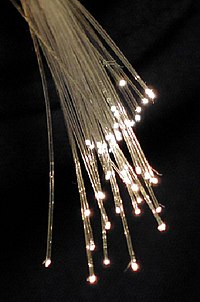
Photo from wikipedia
The mathematical model of a piezoelectroluminescent fiber-optical sensor is developed for diagnostics of the 3D stress state of composite structures. The sensor model is a coaxial sector-compound layered cylinder consisting… Click to show full abstract
The mathematical model of a piezoelectroluminescent fiber-optical sensor is developed for diagnostics of the 3D stress state of composite structures. The sensor model is a coaxial sector-compound layered cylinder consisting of a central optical fiber with electroluminescent and piezoelectric layers and an external uniform elastic buffer layer. The electroluminescent and piezoelectric layers are separated by radial-longitudinal boundaries, common for both layers, into geometrically equal six “measuring elements” — cylindrical two-layered sectors. The directions of 3D polarization of the piezoelectric phases and the frequencies of luminous efficacy of the electroluminescent phases are different in each sector. In the sensor, a thin translucent “internal” controlling electrode is located between the optical fiber and the electroluminescent layer, and the piezoelectric layer is coated by a thin “external” controlling electrode. The results of numerical modeling of the nonuniform coupled electroelastic fields of the piezoelectroluminescent fiber-optical sensor in the loaded “representative volume” of a composite, taking into account the action of the controlling voltage on the internal and external electrodes, of a numerical calculation of “informative and controlling coefficients” of the sensor, and of testing of an arbitrary 3D stress of state of a unidirectional glass-fiber plastic by the finite-element method are presented.
Journal Title: Mechanics of Composite Materials
Year Published: 2018
Link to full text (if available)
Share on Social Media: Sign Up to like & get
recommendations!